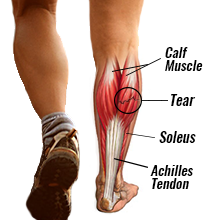If you develop tight calf muscles, it can be due to overactivity or not enough stretching. Tightness in calf muscles can cause pain and soreness. Calf muscles are made up of two main muscles known as the gastrocnemius and the soleus. They are located behind the shin bone and help in pulling the heel up when you walk or stand. These muscles can be impacted due to overuse, for example, if you do vigorous exercise daily.
Tight calf muscles can cause discomfort and difficulty in walking. In this article, we will look at how to relieve tight calf muscles.
Symptoms of tight calf muscles
If you have cramped muscles, then you may experience severe pain and discomfort. Muscles can feel hard and twitch under your skin. If you stretch your muscles too much it can lead to cramping that will last for a few seconds to 15 minutes or more. Cramping can occur a few hours later after exercise.
These are the following symptoms:
- Sharp and sudden pain at the back of your calf
- Swelling or bruising
- Pain while walking
- Trouble standing on your tiptoes
Causes of calf muscle tightness
Calf muscles can become tight due to overuse. Vigorous activities like running or playing sports can put a pressure on your calf muscles. Sometimes even individuals who don’t do lots of activities are at risk of developing tight calves.
Here are some other causes of calf tightness and pain:
- DVT or deep vein thrombosis
- PVD or peripheral vascular disease
- Limited range of motion in the ankle
- Dehydration
- Poor circulation
- Muscle tear
- Dietary imbalances
- Side effects of medicines
Treatments to relieve tight calf muscles
Physiotherapy
If you experience chronic pain often then you may need physiotherapy. A physiotherapist can examine your condition and come up with a treatment plan. This plan can include exercises, stretching, or massage treatments that can promote muscle flexibility. The treatment also reduces pain, swelling and other symptoms you may be experiencing.
A physiotherapist will help you understand the root cause of the problem. Physiotherapy also reduces the chances of these symptoms coming back again.
Stretching and strength exercises
Stretching is a good way to relieve calf muscle tightness. Calf stretching can help lengthen the muscle fiber and reduce pain. It is important to stretch slowly and steadily. Stretching can be uncomfortable but it should not hurt. You can also incorporate strengthening exercises into your routine.
RICE
Try the RICE or rest, ice, compression, and elevation method for immediate relief in the first 48 to 72 hours after you experience calf tightness. After you have done this do not strain your muscles to reduce further damage. Using an ice pack throughout the day, resting, and elevating your leg can be very useful to reduce cramping and pain.
Over-the-counter medications
Over-the-counter pain medications can temporarily relieve any pain you experience.
Tips to prevent tight calves
Here are some tips you can follow to prevent tight calf muscles:
Regular stretching can keep your calf muscles flexible and relaxed.
If you are stretching or exercising it is best to warm up before that to get the blood flowing.
Use footwear that provides more support to your joints and muscles. Flatter shoes can pull your calf and achilles causing tightness to build.
Wearing compression sleeves can help promote blood circulation to your muscles and relieve any pain felt while doing any activity.
Seek regular physical and massage therapy, especially if you do robust training or exercise, to keep your calves free from strain. Physical therapy can promote blood flow and flexibility. This can reduce the chances to get cramps or calf tightness often.
Inactivity can also lead to calf muscle tightness. Hence, ensure that you get some physical exercise throughout the day to reduce calf tightness.
Drink plenty of water and maintain a balanced diet throughout the day.
Complications
In most cases the tightness in calf muscles subsides after home treatment, stretching and rest. It can take some time for muscle tightness to ease. In some cases, this could develop into serious complications such as:
- Shin splints
- Calf pulls
- Stress fractures
- Compartment syndrome
If your calf tightness and pain does not subside after stretching and rest, it could point to other severe conditions that need medical attention. If you experience the following symptoms, then contact your doctor immediately.
- Severe pain
- Swelling
- Discharge
- Inflammation
- Pain growing intense
If you experience calf muscle tightness after certain activity, then you can try home treatments and stretches to relieve pain. However, do not ignore this for too long. If your calf does not feel better or you notice it getting worse then see your doctor immediately. In most cases resting and stretching can help relieve calf pain. For a more permanent solution to chronic calf pain, it is best to seek professional help like physical and massage therapy.
You can book a physiotherapy appointment with us here.


